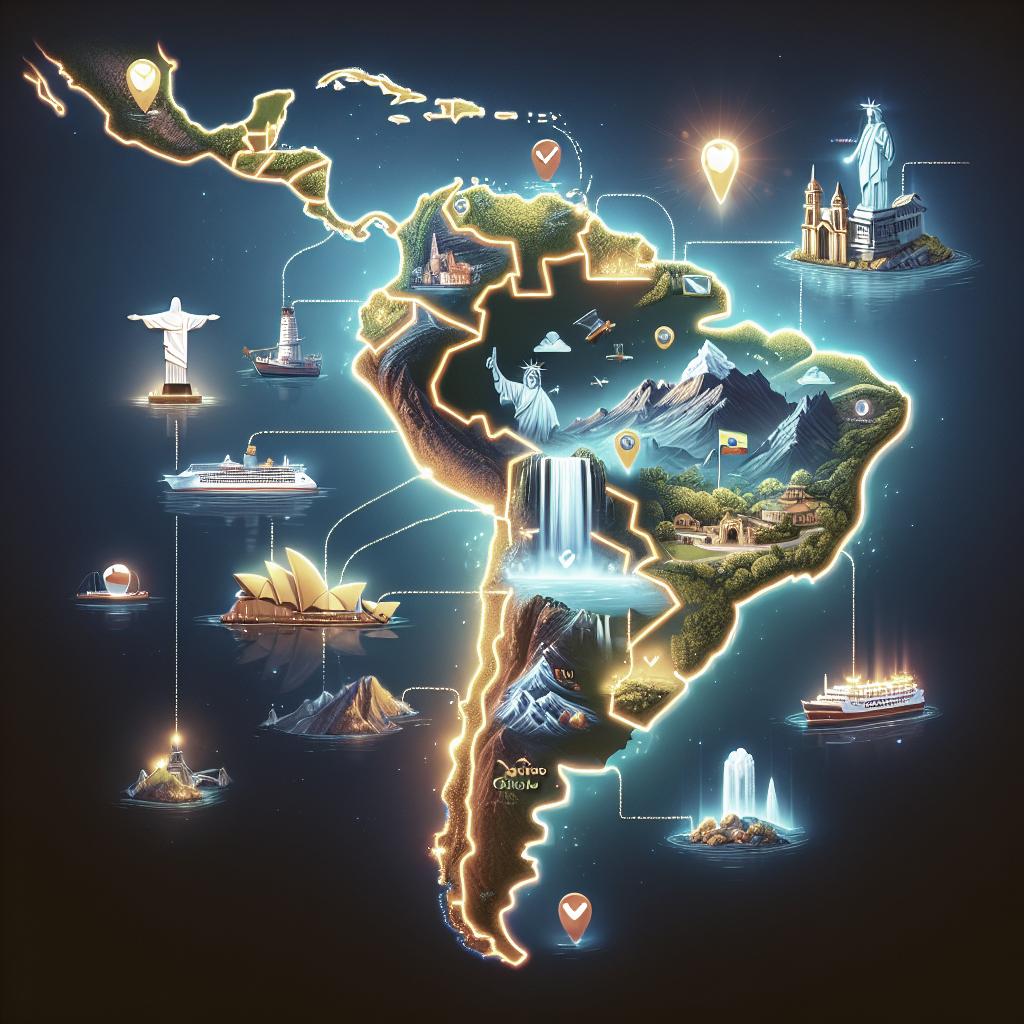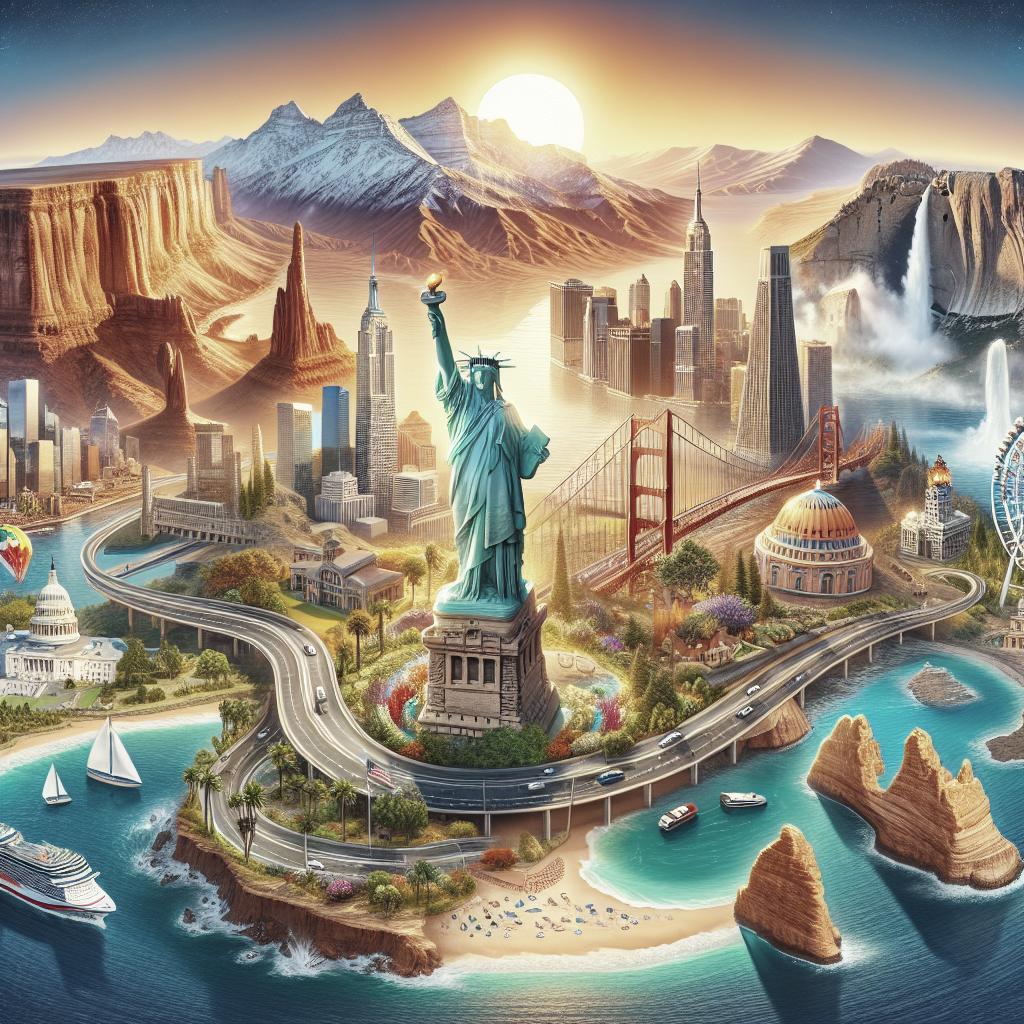“`html
South America is a diverse continent that offers an array of attractions ranging from ancient ruins to pristine beaches, dense jungles to vibrant cities. Whether you’re a history buff, a nature lover, or a fan of unique cultural experiences, this guide covers some of the best destinations you should add to your travel itinerary. From the heights of Machu Picchu in Peru to the unique ecosystem of the Galápagos Islands in Ecuador, these spots promise unforgettable adventures. So pack your bags, grab your camera, and get ready to explore the best countries in South America.
Machu Picchu, Peru
Machu Picchu is one of the most iconic archaeological sites in the world. Nestled in the Andes Mountains, this 15th-century Inca citadel commands respect and awe. Often referred to as the “Lost City of the Incas,” it offers stunning vistas, mysterious ruins, and an opportunity to step back in time. The journey to Machu Picchu can be as rewarding as the destination itself, with multiple trekking options like the Inca Trail available for adventurous travelers.
For those less inclined to hike, a train ride offers a picturesque route through the Sacred Valley, making the site accessible to all types of tourists. Once you reach Machu Picchu, a guided tour will provide deeper insights into the historical and cultural significance of this ancient marvel.
Jardín, Antioquia, Colombia
Jardín is a charming town in Colombia’s Antioquia Department known for its vibrant colors and well-preserved colonial architecture. Often overlooked by tourists, Jardín offers an authentic Colombian experience away from the hustle and bustle of larger cities. The town’s central plaza is adorned with lush gardens, colorful flowers, and inviting cafes where you can sip locally-grown coffee.
Surrounded by verdant mountains, Jardín is a paradise for nature lovers and hikers. The area boasts several trails leading to breathtaking viewpoints and waterfalls. Don’t miss out on taking a cable car to Cristo Rey hill for a panoramic view of this picturesque town and its natural surroundings.
Buenos Aires, Argentina
Buenos Aires is the vibrant heart of Argentina, known for its dynamic culture, rich history, and bustling nightlife. This cosmopolitan city offers a blend of European elegance and Latin American passion. Be sure to visit iconic neighborhoods like La Boca, known for its colorful buildings and tango performances, and San Telmo, famous for its antique markets and cobblestone streets.
The city’s culinary scene is another highlight, featuring world-class restaurants and traditional Argentine steakhouses. Don’t forget to catch a live tango show, wander through the historic Recoleta Cemetery, and explore the lush parks and gardens that make Buenos Aires a diverse and exciting travel destination.
Valparaíso, Chile
Valparaíso is a coastal city in Chile known for its artistic vibe, colorful hillside homes, and labyrinthine streets. The city’s bohemian atmosphere has inspired poets, writers, and artists alike, most notably Pablo Neruda. Valparaíso’s unique charm lies in its gritty, unpolished beauty and its vibrant street art that decorates nearly every corner.
Take a ride on one of the city’s numerous funiculars to explore the hillside neighborhoods and enjoy panoramic views of the Pacific Ocean. Valparaíso’s bustling port area and historic quarter, a UNESCO World Heritage Site, are also worth exploring. The city is a true celebration of creativity and resilience, making it a must-visit destination in South America.
Galápagos Islands, Ecuador
The Galápagos Islands are a natural wonder and one of the most biodiverse places on Earth. Located about 600 miles off the coast of Ecuador, these volcanic islands are home to unique species such as giant tortoises, marine iguanas, and blue-footed boobies. The islands’ isolation has allowed life to evolve in extraordinary ways, making it a living laboratory for scientists and nature enthusiasts.
Visitors can explore the islands by boat, offering opportunities for snorkeling, diving, and up-close encounters with wildlife. Each island offers distinct landscapes, from white sandy beaches to rugged volcanic peaks. The Galápagos National Park strictly regulates tourism to ensure the preservation of its fragile ecosystem, so be sure to plan ahead and book with authorized tour operators.
Cocora Valley, Salento, Colombia
The Cocora Valley in Salento, Colombia, is a natural paradise known for its towering wax palm trees, which are the tallest palm trees in the world. Located in the Andean mountains, this valley offers a stunning landscape characterized by lush greenery, rolling hills, and a cloud forest that feels almost otherworldly.
The Cocora Valley is perfect for hiking and outdoor activities. Trails vary in difficulty, with some leading to scenic viewpoints and others through dense forests. Horseback riding is another popular way to explore the area. Don’t forget to visit the charming town of Salento nearby, where you can enjoy traditional Colombian culture and cuisine.
The Rock of Guatapé, Colombia
The Rock of Guatapé, also known as El Peñón de Guatapé, is a massive granite monolith rising 200 meters above the landscape in Guatapé, Colombia. This natural wonder offers an exhilarating climb of 740 steps to the summit, where you’ll be rewarded with panoramic views of the surrounding lakes and islands.
In addition to its breathtaking views, the area around The Rock of Guatapé is perfect for water sports and leisure activities. You can rent a boat to explore the labyrinthine waterways, or simply relax in one of the many cafes and restaurants that line the waterfront. The nearby town of Guatapé is also famous for its colorful zócalos (decorative bas-reliefs) that adorn the lower walls of its buildings.
San Rafael, Antioquia, Colombia
San Rafael is a hidden gem located in the Antioquia region of Colombia. Known for its natural beauty and tranquil environment, San Rafael is surrounded by rivers, waterfalls, and lush greenery, making it a perfect escape from the urban grind. The town is growing in popularity among eco-tourists and adventure seekers.
The pristine rivers are ideal for activities like swimming, tubing, and fishing. Hike through scenic trails to discover hidden waterfalls and enjoy the serene ambiance. The hospitality of the local community and the simple yet flavorful cuisine are additional highlights that make San Rafael a memorable destination.
The Lost City, Magdalena, Colombia
The Lost City (Ciudad Perdida) in the Sierra Nevada mountains of Colombia is an ancient archaeological site that pre-dates Machu Picchu by over 600 years. Believed to have been founded around 800 AD, this lost city requires a multi-day trek to reach, but the journey is incredibly rewarding. Trekking through dense jungle, crossing rivers, and climbing stone steps are all part of the adventure.
Once you arrive, the sight of the ancient terraces and ceremonial structures will leave you in awe. The Lost City offers a more secluded and less commercialized experience compared to some other archaeological sites in South America. Local guides, often from indigenous communities, provide valuable insights into the history and cultural significance of the site.
Cusco, Peru
Cusco is the historical heart of the Inca Empire and a vibrant Peruvian city that serves as the gateway to Machu Picchu. Nestled in the Andes, Cusco blends a rich history with contemporary culture, offering travelers a variety of experiences. The city’s cobblestone streets are lined with colonial buildings built on the foundations of ancient Incan temples.
Don’t miss visiting the Plaza de Armas, the central square surrounded by impressive cathedrals and lively cafes. Nearby, the San Pedro Market provides an authentic experience of local life. Explore ancient ruins like Sacsayhuamán and Qorikancha to gain deeper insights into the Inca civilization. Cusco also offers vibrant festivals, artisan markets, and a booming culinary scene.
Rainbow Mountain, Vinicunca, Peru
Rainbow Mountain, also known as Vinicunca or Montaña de Siete Colores, is a strikingly colorful mountain located in the Peruvian Andes. The mountain’s vibrant stripes of red, yellow, green, and blue are a result of its unique mineralogical composition. An increasingly popular trekking destination, Rainbow Mountain offers one of the most photogenic landscapes in Peru.
The trek to Rainbow Mountain is moderately challenging due to the high altitude and steep inclines. However, the effort is well worth it as you’ll be rewarded with panoramic views of the colorful ridges and surrounding peaks. Many tours also include a visit to the nearby Red Valley, adding another layer of natural beauty to your adventure.
Amazon Rain Forest, Peru
The Amazon Rain Forest in Peru offers an unrivaled biodiversity and an opportunity to immerse yourself in one of the world’s most extraordinary ecosystems. The Peruvian Amazon is accessible from several cities, including Iquitos, Puerto Maldonado, and Cusco. Guided tours provide safe and informative ways to explore this expansive jungle.
Whether you’re interested in bird-watching, fishing for piranhas, or hiking through dense forests, the Amazon offers a plethora of activities. Many eco-lodges provide comfortable accommodation and experienced naturalists who can introduce you to the rich flora and fauna. Nighttime excursions reveal a different side of the Amazon, showcasing nocturnal species like frogs, insects, and even jaguars.
Huacachina, Peru
Huacachina is a unique desert oasis located in southern Peru, near the city of Ica. Surrounded by towering sand dunes, this small village is centered around a picturesque lagoon. It’s a popular destination for adventure sports, including sandboarding and dune buggy rides, making it a hit with thrill-seekers.
After an adrenaline-pumping day, relax by the lagoon or take a paddleboat out on the water. The oasis also offers stunning sunsets that paint the sand dunes in shades of orange and red. Local shops and cafes provide a laid-back atmosphere where you can unwind and enjoy the desert scenery.
Colca Canyon, Peru
Colca Canyon is one of the deepest canyons in the world, located in southern Peru. This natural wonder offers dramatic landscapes, including terraced valleys, towering cliffs, and volcanic craters. The canyon is famous for its incredible views and as a habitat for the Andean condor, which can often be seen soaring above the canyon.
Hiking through the canyon provides a challenging yet rewarding experience, with various trails offering different levels of difficulty. You can also visit local villages to learn about traditional agricultural techniques and the region’s unique culture. Colca Canyon is a must-visit destination for those seeking both adventure and tranquility amidst nature’s grandeur.
Lake Titicaca, Peru and Bolivia
Lake Titicaca is renowned for being the highest navigable lake in the world, sitting on the border between Peru and Bolivia. The lake’s tranquil blue waters are steeped in cultural and historical significance, with numerous islands offering unique experiences. One of the most popular is the Uros Floating Islands, made entirely of reeds, where the indigenous Uros people live.
Another highlight is Taquile Island, known for its well-preserved traditions and intricate textiles. A boat tour of Lake Titicaca grants you the opportunity to explore these islands and engage with local communities. The lake’s serene beauty and cultural richness make it a compelling destination for any traveler.
Uyuni Salt Flat, Bolivia
The Uyuni Salt Flat, or Salar de Uyuni, is a surreal natural wonder located in southwest Bolivia. Spanning over 10,000 square kilometers, it is the largest salt flat in the world. The strikingly white landscape creates an almost otherworldly atmosphere, especially during the rainy season when a thin layer of water transforms it into a colossal mirror.
Visitors can embark on multi-day tours that include stops at other remarkable sites like the Train Cemetery, various colorful lagoons, and geothermal geysers. The night sky in the salt flat is also a breathtaking spectacle, making it a great spot for stargazers. The Uyuni Salt Flat is a place that must be seen to be believed.
Pantanal Wetland, Brazil
The Pantanal Wetland in Brazil is one of the largest tropical wetlands in the world, teeming with diverse wildlife. Unlike the dense Amazon rainforest, the Pantanal offers wide-open spaces that make wildlife viewing significantly easier. This biodiversity hotspot is a paradise for animal lovers and bird watchers.
From jaguars to capybaras, caimans to giant otters, the Pantanal is home to numerous species that can often be seen from the comfort of a boat or safari vehicle. Guided tours led by expert naturalists provide insightful information about the ecosystem and its inhabitants. Whether you’re a seasoned naturalist or a casual observer, the Pantanal offers unparalleled opportunities to connect with nature.
Petrópolis, Brazil
Petrópolis, also known as The Imperial City, is located in the mountains near Rio de Janeiro. This charming city served as the summer residence of the Brazilian Emperor Dom Pedro II and retains much of its regal charm. The city is famous for its well-preserved architecture, lush gardens, and serene atmosphere.
Key attractions include the Imperial Museum, housed in the former summer palace of the emperor, and the Cathedral of São Pedro de Alcântara, where many members of the imperial family are buried. Petrópolis is also a gateway to scenic mountain trails, making it a great destination for both history buffs and nature lovers.
Christ the Redeemer, Rio de Janeiro, Brazil
Christ the Redeemer is one of the most iconic landmarks in the world and a symbol of Rio de Janeiro. The massive statue stands atop the Corcovado Mountain, offering breathtaking views of the city and its surrounding landscape. Standing at 30 meters tall, the statue is a monument to Brazilian Christianity and a marvel of engineering.
Visitors can reach the summit via a scenic train ride or by hiking up the forested trails of Tijuca National Park. Once at the top, you’ll be treated to panoramic views of Rio, including Sugarloaf Mountain, Copacabana Beach, and the sprawling urban landscape below. Christ the Redeemer is a must-see for anyone visiting Brazil.
Sugarloaf Mountain, Rio de Janeiro, Brazil
Sugarloaf Mountain is another iconic landmark in Rio de Janeiro, known for its distinctive rounded peak that rises nearly 400 meters above the harbor. Accessible by cable car, the summit offers stunning 360-degree views of the city, the coastline, and the surrounding mountains.
Visitors can take the two-stage cable car ride, which offers equally spectacular views during the ascent. The mountain is also a popular spot for rock climbing, with routes suitable for various skill levels. Whether you’re an adventure seeker or simply looking to capture incredible photos, Sugarloaf Mountain provides an unforgettable experience.
Iguazú Falls, Puerto Iguazú, Argentina
Iguazú Falls is one of the most breathtaking natural wonders in the world, located on the border between Argentina and Brazil. Comprising over 250 individual waterfalls, the immense scale of Iguazú is awe-inspiring. The falls are surrounded by lush rainforest, which is home to a variety of wildlife, including toucans, monkeys, and coatis.
Visitors can explore the falls from multiple viewpoints via a network of walking trails and boardwalks. Boat tours offer an exhilarating way to experience the falls up close, while helicopter rides provide a different perspective from above. Iguazú Falls is a destination that promises to leave you spellbound by nature’s power and beauty.
Patagonia, Argentina
Patagonia is a vast region that spans parts of Argentina and Chile, known for its dramatic landscapes and rugged beauty. Argentine Patagonia is home to some of the world’s most spectacular natural wonders, including the Perito Moreno Glacier and the Fitz Roy mountain range. The region offers endless opportunities for outdoor adventures, from trekking and climbing to wildlife watching and kayaking.
The town of El Calafate is the gateway to Los Glaciares National Park, where you can witness the awe-inspiring Perito Moreno Glacier. Further north, the town of El Chaltén is a hiker’s paradise, with trails leading to the iconic peaks of Fitz Roy and Cerro Torre. Patagonia’s wild, unspoiled beauty makes it a haven for nature lovers and adventure enthusiasts.
Zuccardi Winery, Uco Valley, Argentina
Zuccardi Winery, located in the Uco Valley region of Mendoza, Argentina, is a world-renowned destination for wine lovers. The Uco Valley is known for producing some of Argentina’s best wines, particularly Malbec. Zuccardi Winery stands out for its innovative approach to winemaking and its commitment to sustainability.
Visitors can take guided tours of the vineyard, learn about the winemaking process, and, of course, enjoy tastings of their exceptional wines. The winery’s stunning architecture and picturesque setting add to the overall experience. A visit to Zuccardi Winery is an enriching and delightful way to appreciate the artistry of Argentine wine production.
Punta del Este Beaches, Uruguay
Punta del Este, located on the southeastern coast of Uruguay, is a glamorous beach resort town known for its beautiful beaches, upscale resorts, and vibrant nightlife. Often referred to as the “Saint-Tropez of South America,” Punta del Este attracts a mix of international jet-setters, celebrities, and sun-seekers.
Some of the most popular beaches include Playa Brava, known for its strong surf and the iconic “Hand in the Sand” sculpture, and Playa Mansa, which offers calmer waters and a family-friendly atmosphere. The town also boasts a lively arts scene, with galleries, cultural events, and the famous Casapueblo, a unique building created by artist Carlos Páez Vilaró. Punta del Este provides an ideal blend of relaxation, culture, and excitement.
Easter Island, Chile
Easter Island, or Rapa Nui, is one of the most remote inhabited islands in the world, located in the southeastern Pacific Ocean. It is famous for its mysterious moai statues, massive stone figures that were carved by the island’s early inhabitants. These statues are scattered across the island, with the largest concentration found at the Rano Raraku quarry and Ahu Tongariki.
Visitors to Easter Island can explore the island’s archaeological sites, hike to volcanic craters, and learn about the rich cultural heritage of the Rapa Nui people. The island’s stunning landscapes, including pristine beaches and rolling hills, add to its allure. Easter Island offers a unique and unforgettable experience that combines natural beauty with ancient history.
| Destination | Country | Highlights |
|---|


